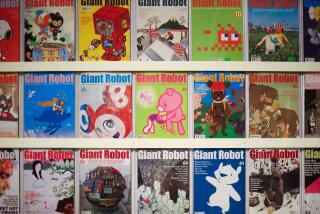Matsumi Kanemitsu; Artist Combined East With West
- Share via
Matsumi Kanemitsu, whose paintings bisected two worlds--one with brush strokes reminiscent of the Sumi paintings of his ancestral land and the other of abstractions that grew from the years he spent in New York studying with Jackson Pollock, Franz Kline and Willem de Kooning--is dead.
Kanemitsu, who spent much of the later part of his life in Los Angeles where he helped inspire the conversion of downtown offices and warehouses into stylish loft living, was 69 when he died Monday of lung cancer at his own downtown loft studio apartment.
Born in Utah and raised in Japan, Kanemitsu spent most of the 1950s and early ‘60s in New York after studying earlier in France, Italy, Hawaii and San Francisco. Today, many of his paintings can be found in those disparate locales.
He also taught at UC Berkeley, Cal State Los Angeles, Otis Art Institute and California Institute of the Arts, among other schools.
Kanemitsu put down roots in Los Angeles in 1965 where he applied the light and space of Southern California to the Sumi and Hake traditions of Japan in what evolved into a series of “naturescapes” in which landscape and other natural phenomena are joined into vacillating gestures of impasto.
Earlier he had been involved in the Tamarind Lithography Workshop in Los Angeles, helping to revitalize the medium under a Ford Foundation Fellowship. His print “Oxnard Madame” was chosen for the cover of the UCLA catalogue “Lithographs From the Tamarind Workshop.”
Over the years he passed through a number of periods, shifting his emphasis from color to minimal and geometric compositions. He used expressive metaphors for his skies and landscapes, executing them with the papers, brushes and inks indigenous to Japan.
But as he worked here over the years, some critics came to feel that his paintings began to lose some of their visceral edge and vibrancy, centering more on style than meaning.
Many of his works are held in eastern museums and private collections, including the Museum of Modern Art in New York, the Philadelphia Museum, the National Gallery of Art in Washington, the Baltimore Museum of Art and the Chrysler Museum in Virginia as well as museums in Hiroshima, Nagoya and Moscow.
In California, his efforts are part of the collections at the Los Angeles County Art Museum, the San Francisco Museum of Modern Art and at UCLA.
His survivors include his three children.
More to Read
The biggest entertainment stories
Get our big stories about Hollywood, film, television, music, arts, culture and more right in your inbox as soon as they publish.
You may occasionally receive promotional content from the Los Angeles Times.










